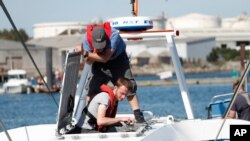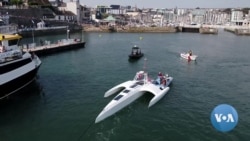A fully autonomous ship named for the Mayflower, the ship that sailed to what is now the eastern U.S. state of Massachusetts, left Plymouth Harbor in southwestern Britain Tuesday to retrace the original’s 5,000-kilometer voyage.
If successful, the 15-meter Mayflower 400 would be the largest autonomous vessel to cross the Atlantic. The $1.3 million ship was built by a nonprofit marine research organization named ProMare in partnership with the computer-tech giant IBM. It is powered by a combination of wind and solar energy, with a back-up diesel generator.
ProMare co-founder and project director Brett Phaneuf said the ship is designed to test a variety of different technologies, as well as research the ocean. Computing and artificial intelligence systems supplied by IBM — and more commonly used by financial services firms — help it make decisions at sea without human help.
A range of equipment including cameras and radar allow the craft to sense the world around it and detect hazards. The vessel is also loaded with instruments to measure ocean health, including a "tongue" to taste seawater chemicals, and an acoustic payload to listen for whales and dolphins.
Phaneuf, who originally built submarines and has extensive experience with robotics and underwater systems, told The Associated Press he sees practical applications for the technology used in the Mayflower 400.
“I think you'll start seeing it in short hauls, water taxis and ferries, where you can reduce the crew and increase the safety, and maybe get to a point in a few years where they're just fully autonomous systems,” he said.
The ship was launched and christened last September, 400 years to the day after the original Mayflower left Plymouth carrying settlers, who became known as Pilgrims.
The team behind the Mayflower 400 say the ship's journey should take about two weeks. It is hoping to end up in Provincetown, on the tip of Cape Cod, the original Mayflower’s 1620 landing point.











